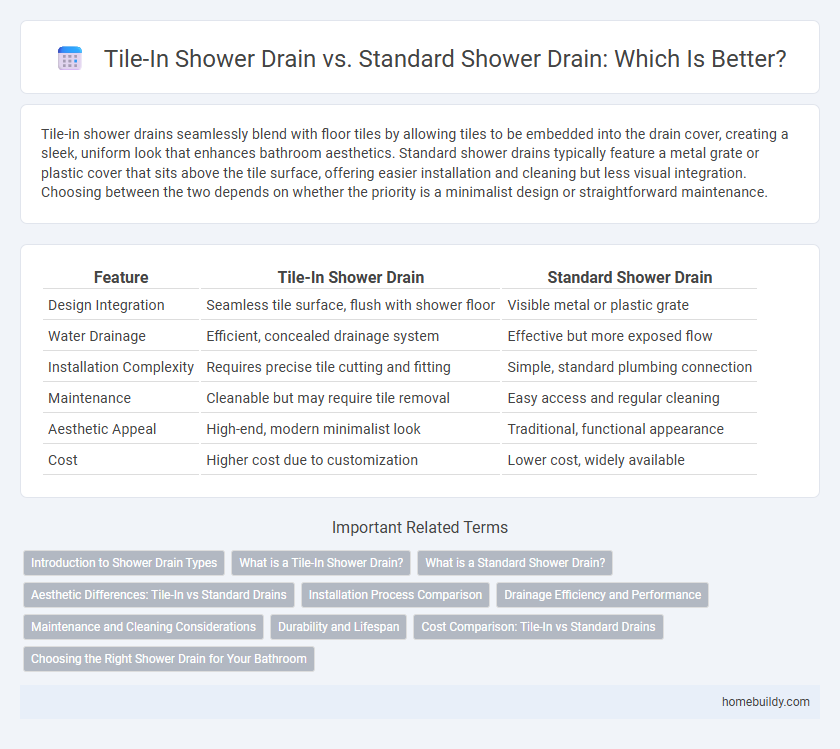Tile-in shower drains seamlessly blend with floor tiles by allowing tiles to be embedded into the drain cover, creating a sleek, uniform look that enhances bathroom aesthetics. Standard shower drains typically feature a metal grate or plastic cover that sits above the tile surface, offering easier installation and cleaning but less visual integration. Choosing between the two depends on whether the priority is a minimalist design or straightforward maintenance.
Table of Comparison
| Feature | Tile-In Shower Drain | Standard Shower Drain |
|---|---|---|
| Design Integration | Seamless tile surface, flush with shower floor | Visible metal or plastic grate |
| Water Drainage | Efficient, concealed drainage system | Effective but more exposed flow |
| Installation Complexity | Requires precise tile cutting and fitting | Simple, standard plumbing connection |
| Maintenance | Cleanable but may require tile removal | Easy access and regular cleaning |
| Aesthetic Appeal | High-end, modern minimalist look | Traditional, functional appearance |
| Cost | Higher cost due to customization | Lower cost, widely available |
Introduction to Shower Drain Types
Tile-in shower drains offer a seamless look by integrating the shower floor tiles directly into the drain cover, enhancing aesthetic appeal and preventing water pooling. Standard shower drains typically feature pre-designed grates that are easy to install but may disrupt the tile pattern and visual continuity. Choosing between tile-in and standard drains depends on desired bathroom design, installation complexity, and maintenance preferences.
What is a Tile-In Shower Drain?
A tile-in shower drain is specifically designed to integrate seamlessly with tile flooring by allowing the tile to be installed directly over the drain cover, creating a continuous surface that enhances aesthetic appeal. Unlike standard shower drains, which typically have exposed metal grates, tile-in drains feature a removable grate that supports custom tiling, ensuring water flows efficiently while maintaining a minimalist look. This design not only prevents water pooling but also simplifies cleaning and maintenance in tiled shower areas.
What is a Standard Shower Drain?
A standard shower drain typically features a fixed grate or cover that sits above the shower floor, designed for straightforward water drainage and ease of installation. Unlike tile-in shower drains that integrate seamlessly with the tile surface for a sleek, flush appearance, standard drains are usually made of metal or plastic with visible grates or strainers. These drains prioritize functionality and cost-effectiveness but may not offer the same aesthetic appeal or custom fit as tile-in options.
Aesthetic Differences: Tile-In vs Standard Drains
Tile-in shower drains seamlessly integrate with bathroom flooring by allowing tiles to extend over the drain cover, creating a uniform and minimalist look that enhances modern bathroom aesthetics. Standard shower drains feature pre-designed metal grates, which stand out visually and may interrupt the continuity of tiled surfaces, making them more noticeable. The tile-in option offers a customizable finish that blends attractively with various tile patterns and colors, elevating the overall design while standard drains prioritize functionality over visual harmony.
Installation Process Comparison
Tile-in shower drains require precise integration with the surrounding tile for a seamless, watertight finish, demanding careful measurements and alignment during installation to prevent leaks. Standard shower drains typically have a simpler installation process, connecting directly to the plumbing without the need for tile integration, which reduces labor time and complexity. Choosing between the two depends on the desired aesthetic and whether the homeowner prioritizes a flush, discreet appearance or straightforward installation.
Drainage Efficiency and Performance
Tile-in shower drains enhance drainage efficiency by providing a flush, seamless integration with the shower floor, preventing water pooling and promoting faster water flow. Their design minimizes debris accumulation and clogs compared to standard shower drains, which often feature raised or inset grates that can impede water movement. Optimized water removal and reduced maintenance make tile-in drains a superior choice for performance in modern shower installations.
Maintenance and Cleaning Considerations
Tile-in shower drains offer a sleek, low-profile design that minimizes grout and tile buildup, making maintenance easier compared to standard shower drains with exposed grates. Cleaning tile-in drains requires attention to the tight seams between tiles and drain covers to prevent mold and debris accumulation. Standard shower drains allow quicker access for routine cleaning but often trap hair and soap scum more visibly, necessitating more frequent unclogging.
Durability and Lifespan
Tile-in shower drains offer enhanced durability due to their seamless integration with the surrounding tile, reducing the risk of water infiltration and damage over time. Standard shower drains, often made from stainless steel or plastic, may be more prone to corrosion or wear, leading to a shorter lifespan compared to tile-in models. The lifespan of tile-in drains typically exceeds 15 years when properly installed, while standard drains may require replacement within 10 years under regular use conditions.
Cost Comparison: Tile-In vs Standard Drains
Tile-in shower drains typically cost between $100 and $500, reflecting their integrated design that seamlessly blends with the surrounding tiles, while standard shower drains range from $20 to $100, offering a more straightforward installation. The higher upfront expense of tile-in drains is often justified by enhanced aesthetics and improved water drainage efficiency, potentially increasing shower lifespan and reducing maintenance costs over time. Standard drains may incur additional costs due to frequent replacements or repairs caused by water pooling and slower drainage.
Choosing the Right Shower Drain for Your Bathroom
Tile-in shower drains offer a seamless, customizable finish by allowing tiles to be integrated directly into the drain cover, enhancing the bathroom's aesthetic with a flush, modern look. Standard shower drains, typically made of metal or plastic with a fixed grate, prioritize function and ease of installation but may disrupt tile patterns and interrupt floor continuity. Selecting the right shower drain depends on balancing design preferences, maintenance requirements, and waterproofing compatibility to ensure both style and durability in your bathroom remodel.
tile-in shower drain vs standard shower drain Infographic

 homebuildy.com
homebuildy.com